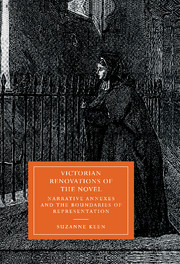Book contents
- Frontmatter
- Contents
- Acknowledgments
- 1 Narrative annexes: altered spaces, altered modes
- 2 Victorian critics, narrative annexes, and prescriptions for the novel
- 3 Norms and narrow spaces: the gendering of limits on representation
- 4 Narrative annexes, social mobility, and class anxiety
- 5 Older, deeper, further: narrative annexes and the extent of the Condition of England
- 6 Victorian annexes and modern form
- Notes
- Bibliography
- Index
- CAMBRIDGE STUDIES IN NINETEENTH-CENTURY LITERATURE AND CULTURE
1 - Narrative annexes: altered spaces, altered modes
Published online by Cambridge University Press: 13 November 2009
- Frontmatter
- Contents
- Acknowledgments
- 1 Narrative annexes: altered spaces, altered modes
- 2 Victorian critics, narrative annexes, and prescriptions for the novel
- 3 Norms and narrow spaces: the gendering of limits on representation
- 4 Narrative annexes, social mobility, and class anxiety
- 5 Older, deeper, further: narrative annexes and the extent of the Condition of England
- 6 Victorian annexes and modern form
- Notes
- Bibliography
- Index
- CAMBRIDGE STUDIES IN NINETEENTH-CENTURY LITERATURE AND CULTURE
Summary
INTRODUCTION
This study of the Victorian novel identifies a technique employed across its various kinds – in social fictions, fictional autobiographies, Bildungsromanen, Condition of England novels, romances, and realistic novels – to renovate the nineteenth-century house of fiction. Narrative annexes, as I name them, allow unexpected characters, impermissible subjects, and plot-altering events to appear, in a bounded way, within fictional worlds that might be expected to exclude them. Like other Victorian renovations, narrative annexes may appear to disfigure the structure they alter, but they at the same time reveal Victorian novelists5 creative responses to the capacities and limitations of their form. Annexes are initiated by a combined shift in genre and setting that changes the fictional world of the novel, and they work by interrupting the norms of a story's world, temporarily replacing those norms, and carrying the reader, the perceiving and reporting characters, and the plot-line across a boundary and through an altered, particular, and briefly realized zone of difference. In small spaces and few pages, narrative annexes challenge both cultural and literary norms to form imaginative worlds more variously, in sometimes distracting or dissonant interludes. Yet annexes never stop the plot, but serve the story by modifying the story-world. As alternatives to the techniques of fantasy or multiplied plot lines, Victorian annexes simultaneously anticipate the fragmentation associated with modern fiction, and resemble the flexible worldmaking of prose fiction before the novel. Extending and qualifying the boundaries of representation, narrative annexes draw attention and contribute to the generic diversity of the Victorian novel, complicating the traditional opposition of realism and romance.
- Type
- Chapter
- Information
- Victorian Renovations of the NovelNarrative Annexes and the Boundaries of Representation, pp. 1 - 41Publisher: Cambridge University PressPrint publication year: 1997



